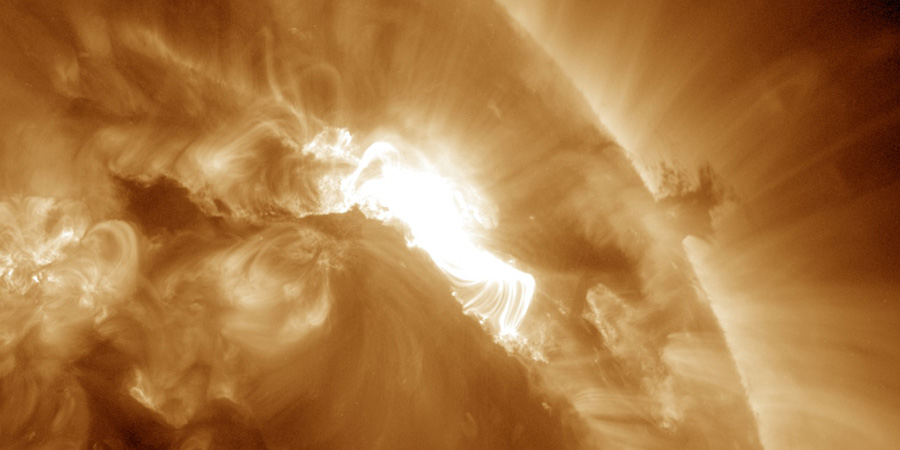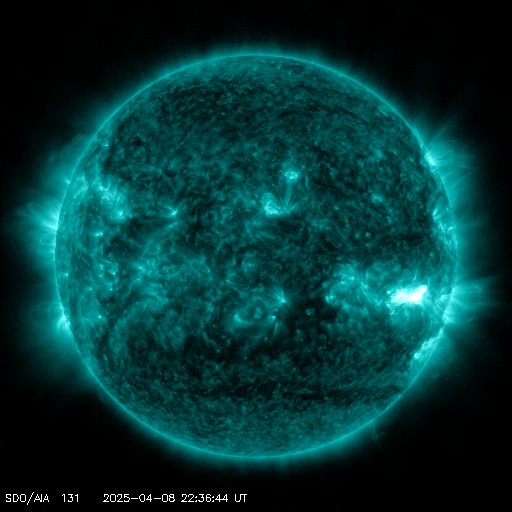M6.3 flare, double CME impact expected
Sunday, 26 February 2023 11:16 UTC

Sunspot region 3229 does it again this time with an M6.2 solar flare that peaked yesterday at 19:44 UTC. This long duration solar flare was again highly eruptive just like the M3.7 solar flare. A minor S1 solar radiation storm followed as a result of this eruption which has minor impacts on HF radio communications at high latitudes.
LASCO imagery reveal an asymmetrical halo coronal mass ejection. Just like with the M3 solar flare, most of the ejecta is heading to the north-west but a good portion of the cloud should have an earth-directed component. The M3 coronal mass ejection is expected to arrive during within the next 12 to 24 hours (early 27 February). The coronal mass ejection from yesterday's M6.2 solar flare is slightly faster and should have a relatively clear path trough interplanetary space meaning it will not slow down too much. This coronal mass ejection could arrive slightly after the from the leading egde of the M3 coronal mass ejection passes Earth. An impact window late on 27 February for the M6.2 coronal mass ejection is reasonable. This means we will see the influences of two coronal mass ejections at the same time late tomorrow moving into 28 February. How will this pan out? Hard to say but we are in for at least two days of geomagnetic unrest where moderate G2 geomagnetic storm conditions seem likely, with a small chance of strong G3 geomagnetic storm conditions which would mean visible aurora from middle latitudes if all goes our way.
Yet another gorgeous eruption from region 3229 this time peaking at M6.3. This eruption is the source of the minor S1 radiation storm we are in right now. A CME has been launched which likely has an earth-directed component but we await more images before a final conclusion. pic.twitter.com/GgIR93uj9q
— SpaceWeatherLive (@_SpaceWeather_) February 25, 2023
Yesterday's M6.3 flare is also associated with an asymmetrical full halo coronal mass ejection. It is slightly faster than the M3 CME and should have a relatively clear path trough space meaning it wont slow down much. This CME is likely to arrive at Earth late on Monday, 27 Feb pic.twitter.com/4gOq9iFfaE
— SpaceWeatherLive (@_SpaceWeather_) February 26, 2023
Thank you for reading this article! Did you have any trouble with the technical terms used in this article? Our help section is the place to be where you can find in-depth articles, a FAQ and a list with common abbreviations. Still puzzled? Just post on our forum where we will help you the best we can!
Current data suggests there is a slight possibility for aurora to appear at the following high latitude regions in the near future
Oulu, Rovaniemi, SodankyläTrondheim
Arkhangelsk, Murmansk, Vorkuta
Kiruna, Luleå, Umeå
Latest news
Latest forum messages
Support SpaceWeatherLive.com!
A lot of people come to SpaceWeatherLive to follow the Sun's activity or if there is aurora to be seen, but with more traffic comes higher server costs. Consider a donation if you enjoy SpaceWeatherLive so we can keep the website online!

Latest alerts
08:12 UTC - Hemispheric Power Index
The OVATION model predicts the Hemispheric Power Index to reach 76GW at 08:57 UTC
02:00 UTC - Geomagnetic activity
Minor G1 geomagnetic storm (Kp5) Threshold Reached: 01:45 UTC
Tuesday, 8 April 2025
23:57 UTC - Hemispheric Power Index
The OVATION model predicts the Hemispheric Power Index to reach 50GW at 00:44 UTC
22:42 UTC - Solar flare
Moderate M1.57 flare
22:24 UTC - Radio Blackout
Minor R1 radio blackout in progress (≥M1 - current: M1.52)
Space weather facts
| Last X-flare | 2025/03/28 | X1.1 |
| Last M-flare | 2025/04/08 | M1.5 |
| Last geomagnetic storm | 2025/04/06 | Kp5 (G1) |
| Spotless days | |
|---|---|
| Last spotless day | 2022/06/08 |
| Monthly mean Sunspot Number | |
|---|---|
| March 2025 | 134.2 -20.4 |
| April 2025 | 148.6 +14.4 |
| Last 30 days | 137.1 -0.2 |




